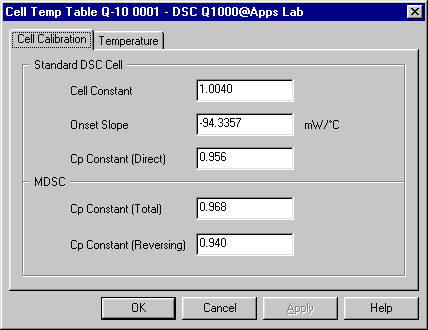 Viewing DSC Cell Calibration Parameters
Viewing DSC Cell Calibration Parameters Viewing DSC Cell Calibration Parameters
Viewing DSC Cell Calibration Parameters
Access the Cell/Temperature Table from the Calibration menu to view the currently loaded calibration constants and temperature calibration points for the cell.
Select from the following topics for more information:










Select
Calibrate/Cell/Temperature
Table from the menu, then click on the Cell
Calibration page to view the calibration constants shown
in the figure below.
NOTE: The information on the Cell Calibration Page will vary based on the model of DSC, current mode, and/or selected heat flow as specified below.
If these values are correct, select OK.
If a change is desired, enter the correct value in the appropriate field and select OK.
Click on the name to link to more information.
Cp (Heat Capacity) Constant (Direct)
Cp (Heat Capacity) Constant (Total or Reversing)
This calibration is based on a run in which a standard metal (e.g., indium) is heated through its melting transition. The calculated heat of fusion is compared to the theoretical value. The cell constant is the ratio between these two values.
The cell constant is applicable to all Q Series™ DSC's, in the standard and modulated modes. In the calibration mode, however, this calibration constant is not applied.
When changing the heat flow selection on the DSC, it is necessary to calibrate for heat flow (cell constant calibration) and temperature.
Cell Constant calibration must be performed after completion of a Tzero cell capacitance and resistance calibration to obtain accurate, calibrated data.
This parameter is the slope of the onset of the melting curve for a standard. The onset slope, or thermal resistance, is a measure of the temperature drop that occurs in a melting sample in relation to the thermocouple. Theoretically, a standard sample should melt at a constant temperature. As it melts and draws more heat, a temperature difference develops between the sample and the sample thermocouple. The thermal resistance between these two points is calculated as the onset slope of the heat flow versus temperature curve on the front side of the melting peak. This is always a negative term. Default is 0.00 mW/°C.
The onset slope constant is applicable to all Q Series DSC's, in the standard and modulated modes. In the calibration mode, however, this calibration constant is not applied. Changes to the DSC heat flow selection require that you recalibrate cell constant and temperature.
See also: Calibrating the Enthalpy (Cell) Constant
Heat capacity can be directly measured on the DSC Q2000/Q1000 in standard mode. The heat capacity calibration is required if it is desirable to measure the absolute value of the sample's heat capacity. The calibration uses a standard material (such as sapphire) with a known heat capacity at a specific temperature of interest. Before performing the calibration experiment, the previously used calibration values need to be manually set to the default value of 1.0. Calibration is typically done at a heating of 10 to 20 °C/min.
NOTE: This calibration is performed in the standard mode.
At the end of the experiment the heat capacity calibration constant is calculated by dividing the theoretical value of heat capacity, at the desired temperature, by the measured value. The calculated Cp Constant (Direct) is then manually entered into the instrument control software on the Cell/Temperature Table accessed from the Calibrate menu, where it is automatically applied to future experiments.
MDSC heat capacity calibration is only required if it is desirable to measure the absolute value of the sample's heat capacity. The calibration, which is performed in Modulated mode, uses a standard material (such as sapphire) with a known heat capacity at a specific temperature of interest. Before performing the calibration experiment, previously used calibration values need to be manually set for both Heat Capacity and Reversing Heat Capacity to the default values of 1.0. Except for heating rate, the calibration experiment should be run under similar conditions (pan type, modulation amplitude, and period) as will be used for subsequent samples. The heating rate can be set to a nominal value of 5 °C/min or the calibration experiment can be performed isothermally, if only calibrating the Reversing Cp signal..
At the end of the experiment the calibration constants for the Total and Reversing Heat Capacity signals are calculated by dividing the theoretical value of heat capacity, at the desired temperature, by the measured value. The constants, MDSC Cp Constant (Total) and MDSC Cp Constant (Reversing), are then manually entered into the instrument control software on the Cell/Temperature Table accessed from the Calibrate menu, where they are automatically applied to future experiments.
NOTE: This calibration is performed in the standard mode.
Calibration constant for the DSC Q20/Q10 or, when the selected Heat Flow is Heat Flow T1, for the other DSC instruments. In the calibration mode this calibration constant is not applied.
Calibration constant for the DSC Q20/Q10 or, when the selected Heat Flow is Heat Flow T1, for the other DSC instruments. In the calibration mode this calibration constant is not applied.
NOTE: Changes to the DSC heat flow selection require that you recalibrate cell constant and temperature.